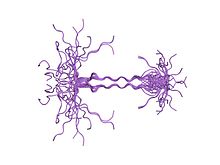Syndecans
| Syndecan | |||||||||
|---|---|---|---|---|---|---|---|---|---|

Solution structure of the Syndecan-4 whole cytoplasmic domain in the presence of phosphatidylinositol 4,5-bisphosphate.
|
|||||||||
| Identifiers | |||||||||
| Symbol | Syndecan | ||||||||
| Pfam | PF01034 | ||||||||
| InterPro | IPR001050 | ||||||||
| PROSITE | PDOC00745 | ||||||||
| SCOP | 1ejp | ||||||||
| SUPERFAMILY | 1ejp | ||||||||
|
|||||||||
| Available protein structures: | |
|---|---|
| Pfam | structures |
| PDB | RCSB PDB; PDBe; PDBj |
| PDBsum | structure summary |
Syndecans are single transmembrane domain proteins that are thought to act as coreceptors, especially for G protein-coupled receptors. These core proteins carry three to five heparan sulfate and chondroitin sulfate chains, which allow for interaction with a large variety of ligands including fibroblast growth factors, vascular endothelial growth factor, transforming growth factor-beta, fibronectin and antithrombin-1. Interactions between fibronectin and some syndecans can be modulated by the extracellular matrix protein tenascin C.
The syndecan protein family has four members. Syndecans 1 and 3 and syndecans 2 and 4, making up separate subfamilies, arose by gene duplication and divergent evolution from a single ancestral gene. The syndecan numbers reflect the order in which the cDNAs for each family member were cloned. All syndecans have an N-terminal signal peptide, an ectodomain, a single hydrophobic transmembrane domain, and a short C-terminal cytoplasmic domain. All syndecans are anchored to plasma membrane via a 24-25 amino acid long hydrophobic transmembrane domain, in contrast to another type of cell surface proteoglycans that attaches to cell membrane using a glycosyl-phosphatidyl-inositol linkage. The most obvious differences between syndecans include (together with differences in distribution) the subclassification of the family depending on the existence of GAG binding sites either at both ends of the ectodomain (syndecan-1 and - 3) or at the distal part only (syndecan-2 and -4) and a relatively long Thr-Ser-Pro-rich area in the middle of syndecan- 3’s ectodomain. The ectodomains show the least amount of amino acid sequence conservation, not more than 10–20%; in contrast, the transmembrane and cytoplasmic domains share approximately 60–70% amino acid sequence identity. The transmembrane domains contain an unusual alanine/glycine sequence motif, while the cytoplasmic domain is essentially composed of two regions of conserved amino acid sequence (C1 and C2), separated by a central variable sequence of amino acids that is distinct for each family member (V).
...
Wikipedia
